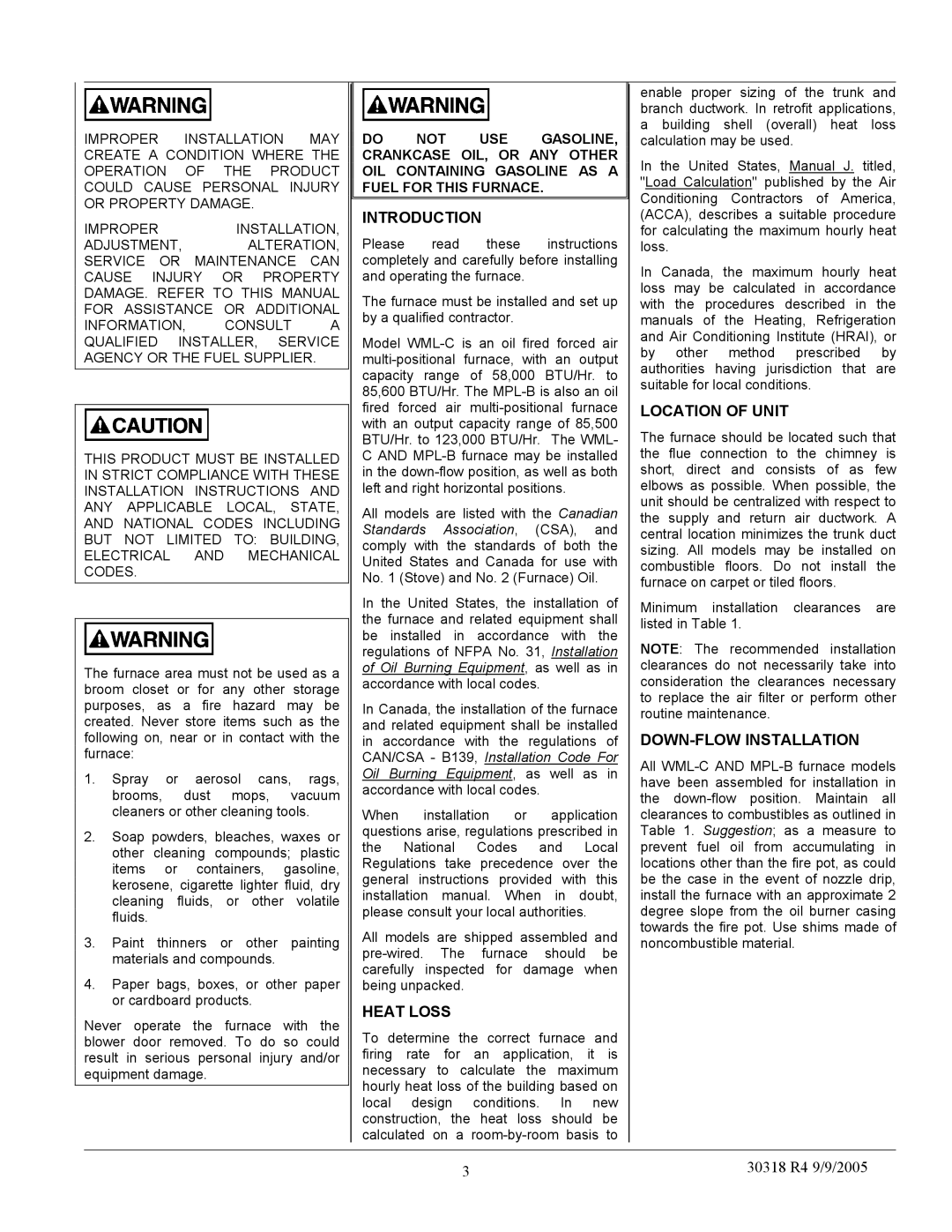IMPROPER INSTALLATION MAY CREATE A CONDITION WHERE THE OPERATION OF THE PRODUCT COULD CAUSE PERSONAL INJURY OR PROPERTY DAMAGE.
IMPROPERINSTALLATION,
ADJUSTMENT, ALTERATION, SERVICE OR MAINTENANCE CAN CAUSE INJURY OR PROPERTY DAMAGE. REFER TO THIS MANUAL FOR ASSISTANCE OR ADDITIONAL
INFORMATION, CONSULT A QUALIFIED INSTALLER, SERVICE AGENCY OR THE FUEL SUPPLIER.
THIS PRODUCT MUST BE INSTALLED IN STRICT COMPLIANCE WITH THESE INSTALLATION INSTRUCTIONS AND ANY APPLICABLE LOCAL, STATE, AND NATIONAL CODES INCLUDING BUT NOT LIMITED TO: BUILDING, ELECTRICAL AND MECHANICAL CODES.
The furnace area must not be used as a broom closet or for any other storage purposes, as a fire hazard may be created. Never store items such as the following on, near or in contact with the furnace:
1.Spray or aerosol cans, rags, brooms, dust mops, vacuum cleaners or other cleaning tools.
2.Soap powders, bleaches, waxes or other cleaning compounds; plastic items or containers, gasoline, kerosene, cigarette lighter fluid, dry cleaning fluids, or other volatile fluids.
3.Paint thinners or other painting materials and compounds.
4.Paper bags, boxes, or other paper or cardboard products.
Never operate the furnace with the blower door removed. To do so could result in serious personal injury and/or equipment damage.
DO NOT USE GASOLINE, CRANKCASE OIL, OR ANY OTHER OIL CONTAINING GASOLINE AS A FUEL FOR THIS FURNACE.
INTRODUCTION
Please read these instructions completely and carefully before installing and operating the furnace.
The furnace must be installed and set up by a qualified contractor.
Model WML-C is an oil fired forced air multi-positional furnace, with an output capacity range of 58,000 BTU/Hr. to 85,600 BTU/Hr. The MPL-B is also an oil fired forced air multi-positional furnace with an output capacity range of 85,500 BTU/Hr. to 123,000 BTU/Hr. The WML- C AND MPL-B furnace may be installed in the down-flow position, as well as both left and right horizontal positions.
All models are listed with the Canadian Standards Association, (CSA), and comply with the standards of both the United States and Canada for use with No. 1 (Stove) and No. 2 (Furnace) Oil.
In the United States, the installation of the furnace and related equipment shall be installed in accordance with the regulations of NFPA No. 31, Installation of Oil Burning Equipment, as well as in accordance with local codes.
In Canada, the installation of the furnace and related equipment shall be installed in accordance with the regulations of CAN/CSA - B139, Installation Code For Oil Burning Equipment, as well as in accordance with local codes.
When installation or application questions arise, regulations prescribed in the National Codes and Local Regulations take precedence over the general instructions provided with this installation manual. When in doubt, please consult your local authorities.
All models are shipped assembled and pre-wired. The furnace should be carefully inspected for damage when being unpacked.
HEAT LOSS
To determine the correct furnace and firing rate for an application, it is necessary to calculate the maximum hourly heat loss of the building based on local design conditions. In new construction, the heat loss should be calculated on a room-by-room basis to
enable proper sizing of the trunk and branch ductwork. In retrofit applications, a building shell (overall) heat loss calculation may be used.
In the United States, Manual J. titled, "Load Calculation" published by the Air Conditioning Contractors of America, (ACCA), describes a suitable procedure for calculating the maximum hourly heat loss.
In Canada, the maximum hourly heat loss may be calculated in accordance with the procedures described in the manuals of the Heating, Refrigeration and Air Conditioning Institute (HRAI), or by other method prescribed by authorities having jurisdiction that are suitable for local conditions.
LOCATION OF UNIT
The furnace should be located such that the flue connection to the chimney is short, direct and consists of as few elbows as possible. When possible, the unit should be centralized with respect to the supply and return air ductwork. A central location minimizes the trunk duct sizing. All models may be installed on combustible floors. Do not install the furnace on carpet or tiled floors.
Minimum installation clearances are listed in Table 1.
NOTE: The recommended installation clearances do not necessarily take into consideration the clearances necessary to replace the air filter or perform other routine maintenance.
DOWN-FLOW INSTALLATION
All WML-C AND MPL-B furnace models have been assembled for installation in the down-flow position. Maintain all clearances to combustibles as outlined in Table 1. Suggestion; as a measure to prevent fuel oil from accumulating in locations other than the fire pot, as could be the case in the event of nozzle drip, install the furnace with an approximate 2 degree slope from the oil burner casing towards the fire pot. Use shims made of noncombustible material.

